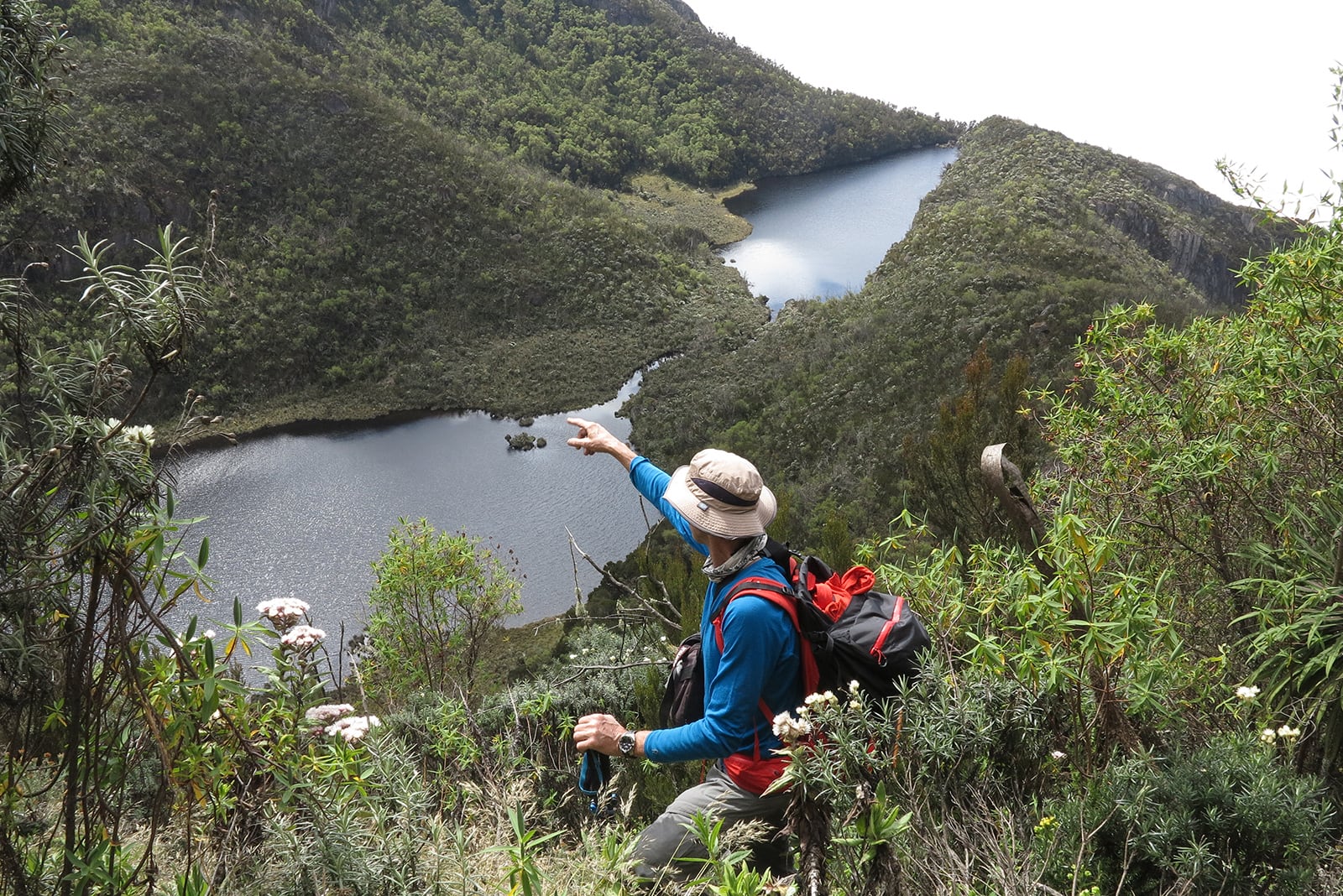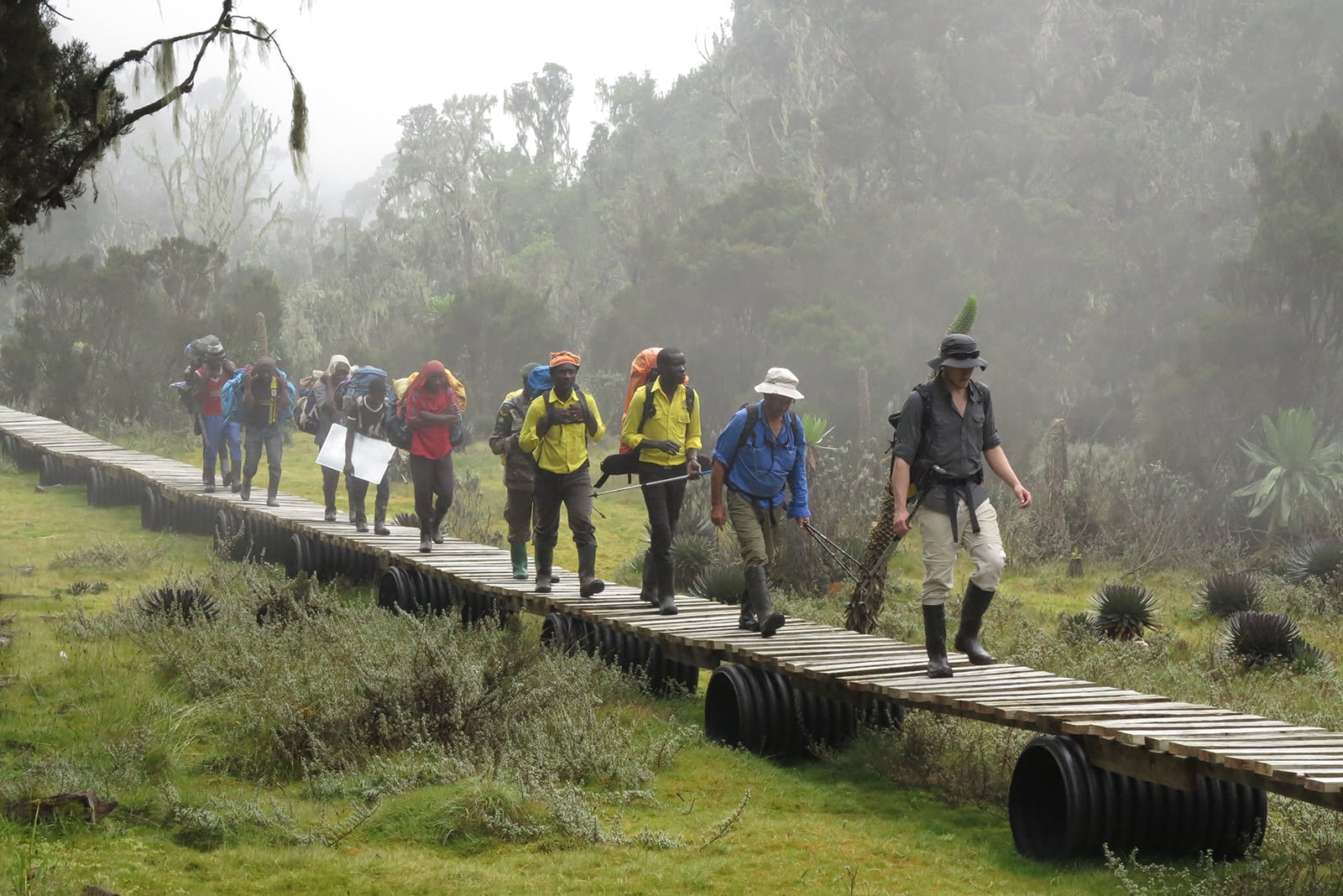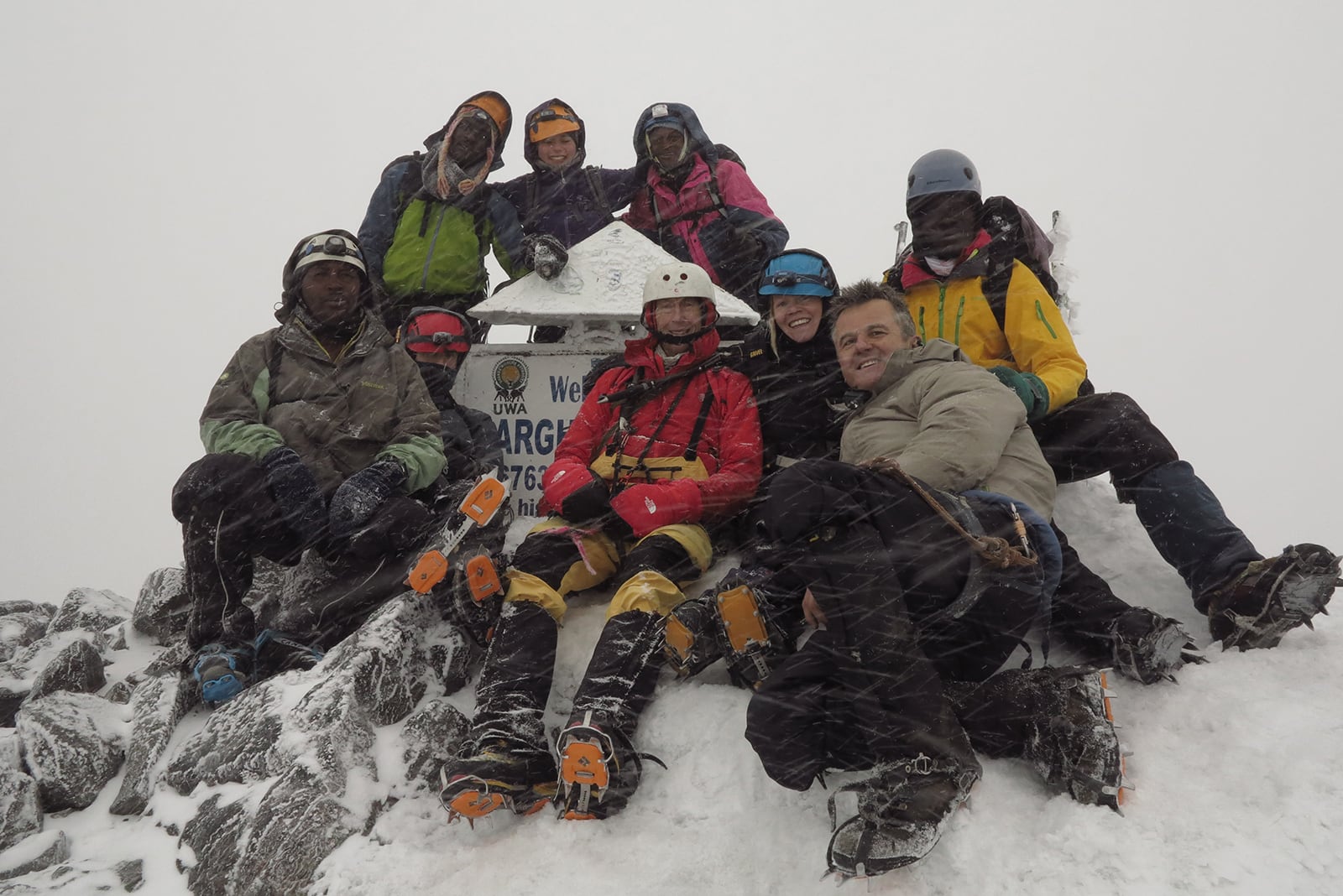Arusha, Tanzania, 1966. Young Timu gazes out of his schoolhouse window, across the heat haze to the dormant volcanic cone of Mt. Meru dominating the skyline to the north of the town, and dreams. His recent school project on African exploration has opened up the continent’s high peaks to his imagination, with the Rwenzori Mountains of Uganda featuring heavily in his research since Europeans theorised it was the source of the Nile. While Mt. Stanley, Africa’s third highest, is too distant to provide a realistic goal for Bwana Kidogo, as he was known, he promises himself that one day he will stand atop Meru and feel the exhilaration of standing in the sky, with nowhere further to go.
Fast forward to the twilight days of 2019. That young lad has since fulfilled his dream and much more besides. Having moved to Australia at the age of twelve, his fascination with the mountains continued. In 1984 he was part of the first Aussie expedition to Mt. Everest, which he climbed via a new route. Six years later he returned to the Himalaya on foot from the Bay of Bengal, the first and still the only person to self-propel himself from sea level to the top of Sagarmartha [Mt Everest]. Soon afterwards he co-founded his company Sea to Summit, which became a global powerhouse in the outdoor gear market. Having sold up a couple of years ago, Tim Macartney-Snape now contents himself leading small groups to remote parts of the globe for adventure travel company World Expeditions. The trip on which I join him, The Triple Peaks of the Rwenzori, has been brewing for over 50 years.
Still smiling, but probably because this is one of least muddy parts of the trail!
Let’s get this out of the way first – the Rwenzori massif is muddy. Uncontrollably, relentlessly muddy. On the first morning, every trekker is issued a pair of gumboots (along with an umbrella and a hot water bottle) which sees way more action than their hiking boots. For days on end, the trail is drowned under a foot of uncircumventable liquid slime. This is the kind of schizophrenic sucking swamp that has more and stronger personalities than our group of nine hardened trekkers combined. There are probably as-yet uncatalogued species of mud here that are found nowhere else on earth. Sometimes a stretch of boardwalk or tree branches laid lengthways aid us in avoiding those hidden voids which have become known as the Portal to the Underbog, or the Franklin Hole of Death.
The unlucky Franklin is a reporter from the Daily Monitor, one of Uganda’s most prestigious newspapers, who falls prey early on to the classic stepping-out-of-his-boot-and-straight-up-to-the-knee-in-his-stockinged-foot manoeuvre. Thanks to the cunning machinations of World Ex’s local agent, the Ugandan media is in love with Tim and has positioned him at the centre of a press whirlwind, and Franklin has been despatched to cover the expedition. The CEO of Uganda Tourism Board has come from Kampala, nearly 400km away, to wave us goodbye at the small trailhead village of Kilembe, which itself throws us an all-singing, all-dancing send-off. Tim bears it all with genial stoicism, making speeches, gladhanding and befriending all and sundry, but inside he’s champing at the bit, as are we all, and it is with unrestrained glee that we finally break away from the circus and into the foothills.
Relatively young at only 3,000,000 years old, the Rwenzoris are the product of the same plate interaction that formed and continues to shape the landscape of Africa’s Great Rift Valley. While they lie on the border with the turbulent Democratic Republic of the Congo, it is fortunately too cold and unpleasant for any of that country’s ample supply of rebel groups to bother making the journey across to kidnap us. Just in case, armed Uganda Wildlife Authority guards make regular patrols up and down the frontier, thus preventing my journal entries from reaching Day 102 (‘Finally released by Mai-Mai militia. Made a lot of new friends. Could do with a shower’).
 Tim strikes ‘Guide’s Pose No.7’ looking out over the Kachope Lakes as they disappear into the Democratic Republic of Congo.
Tim strikes ‘Guide’s Pose No.7’ looking out over the Kachope Lakes as they disappear into the Democratic Republic of Congo.
The evocatively-titled Mountains of the Moon (mistranslated from the indigenous name ‘White Mountains’), were first scaled by European peak bagger the Duke of Abruzzi in 1906 via what is now called the Central Circuit. Mt Stanley has multiple summits, with the 5109m Margherita Peak currently winning the slow race towards the sky. The route World Ex uses was pioneered ten years ago and now boasts a far superior trail system with professional guides and a series of custom-built and well-appointed huts with wood-burning stoves and electricity. Together the two routes bring around 3500 trekkers per year, with less than 500 eyeing-up Margherita as their final goal.
That snow-capped celebration is still far from our minds as we haul our limbs up something resembling the Kokoda Trail on the first afternoon, i.e. steep, slippy and embraced by jungle. “No forest can be grimmer or stranger than this,” wrote the Duke of Abruzzi, but he clearly hadn’t been to Papua New Guinea. As well as four regular guides – a handsome ratio ¬– we have a couple of highly-trained birding-specific guides. Stephen and Narcissi have an impressive ability to identify every feathered friend that flits past, by sight, call and seemingly sense of smell. The Rwenzoris are a birder’s paradise, and while I don’t personally twitch, I can’t help being caught up in the excitement of ticking off endemic species; the Rwenzori double-collared sunbird, Rwenzori turaco and the breasted tit amongst others.
We make headway despite the mud, and in Tim’s case the headway is considerable; our leader has only one speed – Warp Factor Tim. Despite being almost the oldest member of the group (he turns 64 on the final day), he’s constantly snapping at the heels of Basaaja, our front man. Lofty and laconic, and with a more impressive six-pack than I’ve ever had, he strides across the landscape bearing an uncanny resemblance to Roald Dahl’s BFG. His energy is boundless – he does pull-ups whenever possible and stares intently at every rock face picking out possible climbing routes – and after a few days I seriously contemplate hiding a boulder in his daypack to slow him down. At the same time, he is quiet and introverted, almost shy. It takes four full days before he comes out of his shell, but then he is great company. A trove of anecdotes and quick to insert a witticism here and there, he also shares his extensive knowledge of geology, botany and Australiana.
Day-by-day, and blessed with an unusual amount of sun, we rise through the various vegetation zones – tropical rainforest, bamboo, heather, and afro-montane. The latter is a striking landscape of mossy boulders, serene lakes, and giant species of heather, lobelias and groundsels older than Uganda’s independence. We gain altitude at a well-scheduled rate aimed at maximising our acclimatisation, although by the time we scale Observation Peak (4328m) on day three we’re feeling the thinness of the air (Tim included, to my relief). Our enjoyment of the summit is interrupted by a hailstorm which appears out of nowhere and forces us back to Bugata Camp over a field of ankle-punishing hummocks. Rwenzori weather can be politely described as ‘changeable’.
 The team welcomes the chance to walk above the muddy terrain as they follow a section of raised timber boardwalk.
The team welcomes the chance to walk above the muddy terrain as they follow a section of raised timber boardwalk.
By New Year’s Eve we’re so toasted we’re ready to retire to our bunks at 9pm, settling for celebrating midnight in Kazakhstan instead. Seeing our exhausted state, our guides hastily pull out a couple of bottles of wine that have been lugged all the way up here for the occasion. It’s heartening to see a strong female contingent among the porters’ ranks, although there has been strong opposition to their employment as the men believe (or say they believe) that women on the mountain bring bad luck. Any major problem is blamed on their presence, as is demonstrated a few days later when the head guide from another group collapses with pulmonary oedema, having resisted all calls to descend. He has to be carried down and tragically dies in hospital while we are still on the mountain.
It’s only when we crest Bamwanjara Pass, named after the Munyoro man who guided the Duke’s expedition, that we see our final objective rising above us. Tall, craggy, and with a sprinkling of white atop a worn face, Tim is blocking my view, but behind him sits Mt. Stanley, flanked by her twin underlings, Mt. Baker and Mt. Speke. Their grey and frigid walls look worlds away from the fecundity that now surrounds us, but the final zone transition to Alpine occurs the following day, when we bid a sad farewell to verdant, plunging valleys, cute-as-a-button creeks and swathes of harmless-looking but elephant-swallowing marshland. In truth, when the country was recovering from the devastation of Idi Amin’s despotic 1970s reign, the African forest elephant was poached out of this area altogether, another victim of man’s inhumanity to man. We do spot hyrax and duiker but, unsurprisingly, the near-extinct Rwenzori leopard, which no-one has ever successfully photographed, remains elusive.
The day finishes with a shock ending – the hiking equivalent of the final hand-thrusting scene from Carrie – in the form of a hidden and stupidly steep climb up to Margherita Camp. We arrive to a hut wreathed in mist. Steep rock walls rise above us, parted by the white wedge of a glacier peeking through the cloud. Now pushing 4500m, this is serious country. Four years ago, a porter was making his way down alone and lost his way. He was never found. Solo walking is now strictly prohibited. The hut is alive with eager speculation, and also ripe with steaming apparel after the weather gods finally forsook us. After a warming cup of tea, we spend two hours running through the skills we will require early the next morning. We practice tying together for the glacier traverse, using a jumar (ascending device) to haul ourselves up a vertical rope and a prussik to descend. It’s also time for Tim to make a difficult but necessary decision – three clients and Franklin are judged not strong enough to attempt the summit. They will instead try for a lower objective, Stanley Lookout at just under 5000m.
 The tricky bit: Roped up and rugged up, the team traverse the upper section of the Margherita Glacier, just minutes from the summit.
The tricky bit: Roped up and rugged up, the team traverse the upper section of the Margherita Glacier, just minutes from the summit.
For the remainder of us, the twinkling stars that greet our first steps at 2am are soon snuffed out under a blanket of cloud. The smooth, sloped rock is a joy to scamper up but would be treacherous to descend in the wet. Deep scratches, the spoor of crampon-clad winter teams, betray a much lower snowline at times. We work swiftly and silently, despatching the fixed rope sections and traverse of the Elena glacier without issue. When we reach the 150m face of the Margherita glacier, we exhale excitement alongside the warm breath that condenses in the light of our head torches, adding to the blurriness of the reflected fog. While we mortals struggle with the jumar, Tim pulls out twin ice tools and executes a textbook climb alongside the ropes. Show-off!
Our guides display flawless technical skills in setting the anchors and we never feel remotely unsafe. Once the gradient lessens we revert to hind legs and plod to an ice cave below the summit. The dawn light begins to penetrate the thick cloud, leaving us in no doubt as to the quality of the view we can expect at the top – only the finest shades of white will be visible. No matter, we traverse the curtain of icicles and scramble the final minutes to the top of Uganda, smiles undimmed.
 Success! Team Tim celebrate at 5109m with the obligatory summit photo, just before a blizzard arrives to blow them back down the mountain.
Success! Team Tim celebrate at 5109m with the obligatory summit photo, just before a blizzard arrives to blow them back down the mountain.
Within minutes of our warm celebration we’re engulfed by a blizzard and are forced to head down. Its inconvenience is mostly limited to coating all those smooth, sloped boulders with a thin layer of snow, turning them into the hard, cold equivalent of a giant sheet of bubble-wrap. No client’s arse remains unbruised, although watching Basaaja skip along, hands in pockets, makes me wonder. Since 80 per cent of his hiking is on surfaces with the friction of a banana skin, how would he fare in a totally dry environment? Is he so adapted to the slippage that his feet would stick to the ground like glue? Poor Franklin has no such issues; the following day he slips over in a river and sprains his ankle. He is hoisted aloft in a wicker stretcher and surfs down the mountain on a rotating wave of 30 hollering and singing porters. Their boisterous voices are the perfect soundtrack to our triumphant return.
At the periphery of any large gathering in Africa is a fringe of children, staring silently at the proceedings. During the commotion of the Kilembe send-off, after the singing and speechifying, I noticed Tim discretely shaking hands with a small boy and exchanging a few words. Compared to the media commotion and self-important politicians, this child was insignificant, yet Tim took the time to personally introduce himself. Did he see something in this boy? Or was it just a hunch that those few seconds might change a life, inspire a mountaineer as little Timu was inspired by Mt. Meru half a century ago? The future first Ugandan to climb Everest? Only time will tell.
FACT FILE
World Expeditions is the only Australian company to run trips to the Rwenzori. Its Triple Peaks 8-day itinerary included Mt. Baker and Weisman’s Peak, although our group declined to pursue the latter two after Margherita due to the worsening of the weather and subsequent lack of views. While previous experience at altitude and with climbing equipment is useful, it is not considered essential. A reasonable level of fitness is. This from Tim:
“This is definitely one of the toughest regular treks that one can do, because there are big ascents; they are steep and the trail is rough. Even though it’s been well-researched and well-routed, it’s one of the most rugged mountain ranges I’ve ever been in. It’s a really tough trip.”
High season in the Rwenzori is December to March, although intrepid climbers can attempt the summit all year round. Independent trekkers can book the Central Circuit directly with the UWA, although a guide is still mandatory.
See www.worldexpeditions.com for more info.
Source link : https://www.australiangeographic.com.au/australian-geographic-adventure/2023/11/trekking-africas-mountains-of-the-moon/
Author :
Publish date : 2023-11-27 08:00:00
Copyright for syndicated content belongs to the linked Source.






